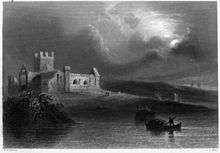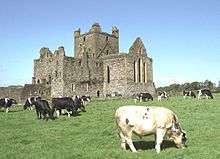Dunbrody Abbey


Dunbrody Abbey is a former Cistercian monastery in County Wexford, Ireland. The cross-shaped church was built in the 13th century, and the tower was added in the 15th century. With a length of 59m the church is one of the longest in Ireland. The visitor centre is run by the current Marquess of Donegall and has one of only two full sized hedge mazes in Ireland.
The abbey was dissolved under Henry VIII. The last Abbot of Dunbrody was Alexander Devereux, who became Bishop of Ferns in 1539.
History
In 1169 a contingent of Norman knights led by the King of Leinster, Dermot MacMurrough, invaded Ireland, first conquering the Irish province of Leinster then all of Ireland. In 1171 Henry II led a much larger force into Ireland, taking control and making Ireland a territory of England. Richard de Clare, one of the important figures in the Norman Conquest, instructed his uncle Herve de Montmorency to found a Cistercian monastery in the County Wexford.[1] Montmorency donated the allotted land to the English Cistercian Abbey of Buildwas. The Abbey of Buildwas sent a lay brother to survey the land and, after an unfavorable report, Buildwas turned down the gift. The property was then offered to St. Mary’s Cistercian Abbey in Dublin, which was in the filial line of Clairvaux.[1] The monks of St. Mary’s were delighted with their new land and they soon sent a community to the site in 1182. Due to its position near a major maritime transportation route, the abbey was placed under the patronage of the Blessed Virgin Mary, with the name Port of St. Mary’s, because of the safety the abbey offered to people in trouble.
The middle of the 13th century was a boom period for the Anglo-Norman colony in Ireland and the Cistercian order shared in this prosperity. The scale and quality of the 13th century buildings constructed at Dunbrody gives a general hint of confidence and well being. The spacious early Gothic church was built sometime around 1210–1240 for the monks of Dunbrody Abbey. Dunbrody, though a relatively small abbey, was very successful until the 16th century and the rise of King Henry VIII. Following his split with the Church of Rome, Henry VIII issued the Dissolution of the Monasteries through a series of administrative and legal processes between 1536 and 1541. Dunbrody was part of the first round of suppressions in Ireland and was officially dissolved in 1536. The abbey was plundered and made unfit for monks to return. The lead from the roof was melted down by using the wood from the roof. Nine years later, Sir Osborne Etchingham was given the land and the monastery which he converted into a residence. Due to the neglect of the private owners of Dunbrody, a massive collapse occurred on Christmas Eve 1852, destroying the south wall of the church and some of the monastery. The abbey lies in ruins until this day.
See also
References
External links
| Wikimedia Commons has media related to Dunbrody Abbey. |
- Dunbrody Abbey (Official Site)
Coordinates: 52°17′01″N 6°57′36″W / 52.2835°N 6.96°W